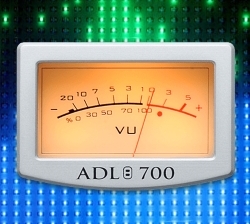
Those Pesky Reference Levels
The real meter madness associated with digital level measurement is when you have devices with different reference levels (volts or dBu vs. 0 dBFS) in the same system.
To make this even more befuddling, you don’t always know a device’s reference level unless you measure it. A lot of gear is specified only in terms of a nominal analog reference level, without revealing the corresponding digital level.
Further, many digital I/O devices have no input or output level controls, so you can’t easily calibrate the reference level to match other gear in your system – you have to accept whatever calibration the manufacturer gives you. It’s bad enough when there’s a standard and not everyone follows it, but in this case there’s no standard for the analog level equivalent to 0 dBFS.
This leads to the common complaint of “my mixes aren’t hot enough” or conversely, “it plays much too loud.”
A dirty little secret is that budget-priced A/D converters (whether a stand-alone converter or integrated into another device) tend to be a bit on the less-sensitive side. It’s more likely that +4 dBu going in will give a digital level in the -20 dBFS ballpark than -12 dBFS. The reason is that with less gain on the front end, they’re digitizing a lower quiescent noise level, so the manufacturer can advertise a lower noise floor on the digital side. You need to hit the input pretty hard in order to get to 0 dBFS.
Sometimes you can crank up the output level of the source—for example a mixer—and sometimes, as with a microphone, you can’t. If there’s something you can adjust, you must take care that you don’t push the source feeding the A/D converter into clipping before the converter reaches maximum digital level. This can occur if you have a mixer with little headroom (a greater risk with older semi-pro mixers than with modern ones) or if you have a mismatch of nominal analog operating levels between the mixer and recorder. If you’re using a recorder with +4 dBu input sensitivity together with a mixer with a nominal operating level of -10 dBV, the only way you’ll be able to get the recorder’s meters to approach zero on peaks is to run the mixer’s output level meter well above zero, which will seriously compromise, and may exceed, the headroom in your mixer.
Loudness in the 21st Century
In the past few years, the audio industry, primarily in response to complaints that television commercials are too loud, has developed a new set of standards for loudness. This is primarily a broadcast thing but there’s now a variety of loudness meters that measure compliance with such loudness standards as ITU-R BS.1770. This is pretty complicated stuff and beyond the scope of this article but don’t be surprised if your DAW gets a plugin for it eventually.
Keep Your Eye on the Ball (Not on the Meter)
Once you’ve properly calibrated the gear in your studio, meters can tell you a lot about what’s happening, but don’t become a slave to them. Use your meters as tools, and you’ll spend more time recording and less time worrying about whether your levels are set properly. Don’t forget that you have a playback volume control. Leave getting the hot levels to the end of the process.
Mike Rivers has an electronic engineering degree and over 35 years as a design, system, and government engineer, while also operating a part-time recording studio and remote-recording truck. He is retired, but he continues to take on occasional projects, such as writing for PreSonus Audio Electronics. The original article, along with plenty of additional links to reference material, can be read here.
